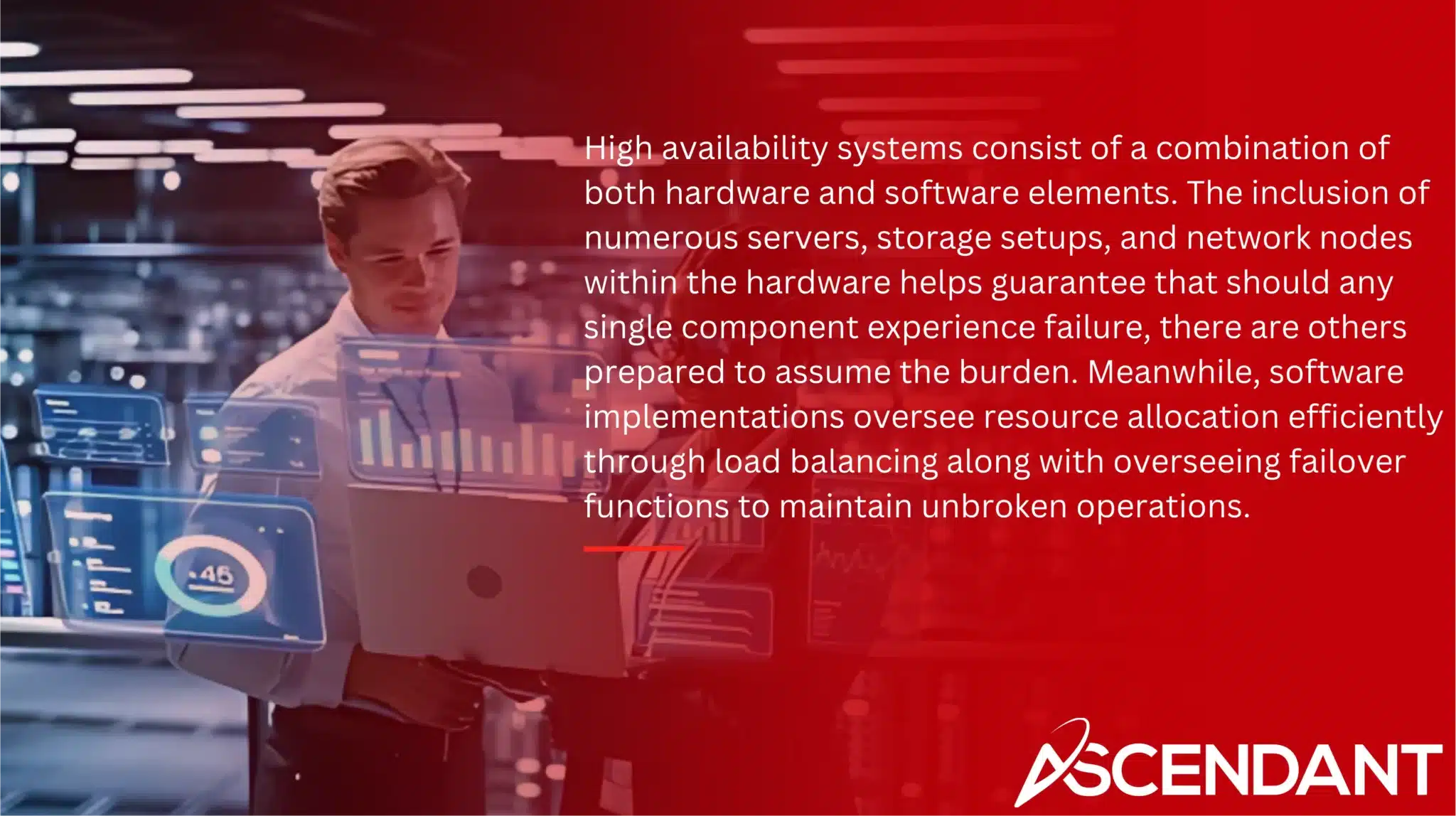High availability (HA) ensures your IT systems stay online and functional with minimal downtime. It’s essential for preventing costly disruptions. This guide explains what high availability is, why it’s crucial for businesses, and how you can achieve it effectively.
In This Article:
- Understanding High Availability (HA)
- Core Components of High Availability Systems
- High Availability Architectures
- Achieving High Availability
- High Availability vs. Disaster Recovery
- Challenges and Best Practices
- Case Studies: Real-World Applications of High Availability
Key Takeaways
- High Availability (HA) aims to ensure operational continuity by swiftly recovering from outages and minimizing service disruptions through redundancy and failover mechanisms.
- Key components of HA systems include redundant hardware and robust software solutions, which together prevent single points of failure and ensure efficient resource management.
- Achieving high availability involves careful design considerations, rigorous testing, and ongoing monitoring to balance performance, cost, and human error prevention while maintaining continuous operation.
Understanding High Availability (HA)
High Availability (HA) is focused on ensuring that HA systems maintain ongoing operations. It includes measures designed to provide support during periods when the system isn’t working properly. A high availability HA system aims for rapid recovery after any failure, aiming to lessen the impact of interruptions in service. High availability is vital for IT systems across different industries, ranging from healthcare—where delays can lead to critical issues—to Big Data environments dependent on uninterrupted data processing.
To attain high availability, it’s necessary to integrate redundancy and failover capabilities into IT systems as well as establish disaster recovery strategies. Technological advancements have greatly improved both dependability and access to HA solutions while also making them more economically viable and operationally effective.
Key Metrics for Measuring Availability
High availability is commonly measured by the amount of uptime a service sustains, with 99.999% being an industry standard goal. To compute this figure, one divides the total uptime of a system by its overall time and then multiplies it by 100. For example, should there be an interruption of services lasting ten minutes within a monthly period, the system’s availability would register at 99.98%.
In high availability systems, Service Level Agreements (SLAs) are vital as they delineate anticipated levels of service including commitments to uptime percentages. These official agreements define performance thresholds for availability and act as benchmarks against which operational performance can be gauged.
Importance of Redundancy
Redundancy plays a pivotal role in maintaining high availability by enabling failover to auxiliary components, thereby reducing downtime caused by the malfunction of any single element. Its main objective is to eliminate single points of failure and guarantee uninterrupted operations if an individual component breaks down.
Incorporating redundancy into hardware setups, such as servers and storage systems, is vital for preserving system reliability. It’s essential that power supplies are duplicated to prevent blackouts. Employing several load balancers also eliminates any potential single point of vulnerability within the overall system architecture, thus reinforcing its robustness against failures.
Core Components of High Availability Systems

High availability systems consist of a combination of both hardware and software elements. The inclusion of numerous servers, storage setups, and network nodes within the hardware helps guarantee that should any single component experience failure, there are others prepared to assume the burden. Meanwhile, software implementations oversee resource allocation efficiently through load balancing along with overseeing failover functions to maintain unbroken operations.
These integral parts come together to constitute a robust high availability infrastructure designed strategically to do away with any single point where failure could occur—thus securing uninterrupted business continuity.
Hardware Components
In systems that require high availability, it is crucial to have duplicate elements such as servers, storage solutions, networking gear, and sometimes even full data centers. Within a cluster designed for high availability, if one server malfunctions, another can seamlessly take over its duties with little to no interruption affecting the entire system’s operations.
The ability to exchange hardware components while the system remains active—referred to as hot-swapping or hot-plugging—increases operational continuity. For instance, by setting up a cluster consisting of two physical nodes, a Chinese financial institution was able to maintain 99.99% uptime for its vital software applications.
Software Solutions
Achieving high availability hinges not only on robust hardware but also on reliable software solutions. To handle the demands of numerous concurrent users effectively, load balancing is vital as it allocates tasks across various system components for optimal resource utilization. By implementing multiple load balancers, organizations can safeguard against service interruptions due to isolated failures.
To minimize disturbances caused by unexpected hardware or software malfunctions, automated failover protocols facilitate swift restoration of services. Employing strategies like high availability clusters coupled with load balancing proves indispensable in constructing efficient failover frameworks.
Take for example a global e-commerce enterprise. Such an entity relies on geographically dispersed databases alongside load balancers to maintain consistent operations amidst periods of elevated traffic during major sales events.
High Availability Architectures
High availability architecture combines various components to sustain uninterrupted continuous operation. Such systems are categorized by their redundancy level, tolerance for failure, and the nature of the system being safeguarded. Database resources typically employ active-active or active-passive configurations to guarantee their availability.
To provide persistent access to services, there is an automatic transition to a backup system for the entire system which helps in removing single points of failure and upholding dependable systems.
Active-Active Configuration
In a setup with an active-active configuration, several systems operate at the same time to facilitate both load balancing and fault tolerance. It is crucial that data remains synchronized across all instances in this arrangement to maintain consistency, as modifications need to be disseminated among every active unit.
Active-Passive Configuration
An active-passive setup features a standby system that takes over when the primary system fails, remaining inactive until then.
Health checks monitor the primary system’s status, ensuring timely detection of failures and switchover capabilities.
Achieving High Availability
Attaining high availability requires a comprehensive strategy encompassing aspects of system design, the establishment of failover mechanisms, as well as thorough testing and monitoring practices. By adopting high availability measures, organizations can mitigate risks related to system downtime and maintain uninterrupted operations.
Nevertheless, reaching this state of high availability typically requires careful consideration of intricate balances among performance metrics, redundancy levels, and financial implications. The influence of variables like geographical redundancy and the current IT infrastructure is critical in determining how high availability solutions are put into place.
System Design Considerations
To attain high availability, it is crucial to remove any single point of failure. The design process is steered by considerations such as the desired levels of uptime, the IT components at hand, and how choices are interconnected. The goal in crafting a high availability system is to achieve the necessary performance and accessibility targets with an eye on reducing both expenses and complexity.
When designing for high availability systems, current IT infrastructure, organizational policies, and available expertise significantly influence outcomes. Committing resources to develop these systems necessitates a meticulous evaluation of cost versus performance benefits along with assessing whether or not the system has the capacity to fulfill these requirements.
Implementing Failover Systems
Components that are redundant enable a system to transition smoothly in the event of failure, which guarantees that there is no substantial disruption in system activities. Redundancy measures are commonly implemented by e-commerce platforms to facilitate rapid recovery from sudden downtime, especially when user traffic is at its peak.
The automation of failover mechanisms plays a key role in sustaining uninterrupted operations and reducing manual mistakes when systems encounter issues. Lifehouse Hospital employs SIOS DataKeeper for real-time data replication, ensuring persistent availability of health information.
Testing and Monitoring
Software designed for high availability often includes tools that oversee system performance and overall condition, utilizing continuous monitoring systems to send automatic notifications to administrators about potential problems.
To confirm the readiness and dependability of high availability systems, routine failover testing is essential. For disaster recovery planning to be effective in crisis situations, it needs consistent testing and periodic revisions.
High Availability vs. Disaster Recovery
High availability is designed to prevent downtime, while disaster recovery is activated after an incident occurs. Although both aim to ensure service continuity, they serve different purposes: high availability focuses on preventing disruptions, while disaster recovery prepares for severe events.
High availability and disaster recovery complement each other in availability and disaster recovery plans, ensuring minimal data loss and continuous service delivery.
Role of Disaster Recovery Planning
Disaster recovery planning acts as a roadmap for reacting to substantial breakdowns that impact numerous systems. This type of planning includes detailed strategies designed to reinstate crucial systems following significant interruptions, taking into account the recovery time objective.
On the other hand, fault tolerance is focused on maintaining continuous operation despite the failure of individual components, distinguishing itself from high availability’s objective of reducing downtime to a minimum.
Fault Tolerance and Zero Downtime
High availability strives to meet particular targets for system accessibility by reducing periods of inactivity, although it does not guarantee constant system availability. The main objective of fault tolerance is to ensure that systems maintain operation without interruption, even when certain components fail.
For applications that are essential to business operations and demand continuous access despite any failures in their components, attaining zero downtime is vital.
Challenges and Best Practices
Establishing high availability requires meticulous strategy and implementation, with an emphasis on optimizing operational effectiveness to diminish both the probability of outages and their potential repercussions.
Maintaining continuous service while negotiating the equilibrium between expenditure and performance, coupled with reducing the risk of errors caused by human involvement, stands among the top methods for attaining high system availability.
Balancing Cost and Performance
Ensuring that high availability systems strike an optimal balance between cost and performance is critical for organizations aiming to fulfill their operational requirements without exceeding budget constraints. The adoption of redundancy and the incorporation of fault tolerance measures can bolster system performance while simultaneously managing expenses by reducing the likelihood of failures.
Leveraging cloud services offers companies the ability to scale their resources adaptively in response to fluctuating demand, achieving a tailored equilibrium between expenditure and capability. A notable illustration of judicious investment balancing lies with e-commerce platforms which selectively channel funds into high availability technologies, particularly aiming to ensure maximum service uptime during periods of intense shopping activity.
Ensuring Continuous Operation
Operations can be considerably interrupted by human errors, resulting in extended downtime and service interruptions. To mitigate these issues, implementing rigorous training protocols and standard operational procedures is essential.
Organizations aiming to achieve high availability must concentrate on preventing human error to maintain the capability for continuous operation. It is vital that high availability systems operate without pause to prevent any disruptions that could affect services.
Case Studies: Real-World Applications of High Availability
Ensuring high availability is vital for sustaining operational performance and guaranteeing reduced system downtime in diverse industries. Practical cases have demonstrated that the adoption of high availability strategies markedly enhances both the dependability of systems and the contentment of users.
Financial Services
In the finance industry, ensuring high availability safeguards against possible losses and upholds trust among investors. To guarantee uninterrupted trading activities, financial organizations employ tactics like duplicating hardware, replicating data in real time, and implementing automatic switchover systems.
Healthcare
High availability is crucial for improved patient care and safety. By implementing high availability strategies, hospitals guarantee uninterrupted access to essential patient care systems. The integration of electronic medical records and life-support systems with high availability solutions provides dependable support for patient care.
To maintain constant access to vital patient data, a vast hospital network relies on a server cluster coupled with real-time data backup mechanisms.
E-commerce
During periods of peak shopping, any period of downtime can result in substantial revenue loss for e-commerce businesses, with the potential financial impact ranging from $301,000 to $400,000 each hour. To ensure maximum uptime during these critical sales events, an international e-commerce company employs a strategy that includes high availability infrastructure complemented by load balancers and distributed databases.
It is imperative for e-commerce platforms to sustain operations without interruption during times when consumer traffic surges.
Telecommunications
The telecom provider adopted a strategy focused on high availability for its network services, which incorporated several data centers, including one equipped with failover capabilities. This tactic guaranteed strong and stable network performance, while also keeping service interruptions to a minimum.
Summary
Ensuring minimal downtime and uninterrupted functioning, high availability is an essential aspect of contemporary IT systems. Organizations that grasp the principal measurements, necessity for redundancy, fundamental elements, and diverse structures can create and deploy potent solutions for high availability. Illustrations from sectors such as finance, healthcare, online retailing, and telecom demonstrate the pivotal importance of high availability in preserving operational efficiency and accomplishing ongoing business operations. Adopting these strategies results in notable enhancements in dependability and client satisfaction, which are instrumental for fostering a sturdy and productive technological landscape.
Frequently Asked Questions
What is 99.999% availability?
The term “five 9s” signifies a system’s operational status at 99.999% availability, which equates to experiencing less than six minutes of downtime over the course of an entire year.
Such a high degree of reliability sets the benchmark for almost flawless ongoing service without interruptions.
What are the three main high availability strategies?
The three main high availability strategies are redundancy, failover, and load balancing. Implementing these strategies ensures continuous operation and minimizes downtime in critical systems.
What are the 3 major principles to ensure high availability?
It is crucial for maintaining high availability to eradicate any single point of failure, establish reliable crossover mechanisms, and ensure that failures are promptly detected when they happen.
Adhering to these guidelines helps in creating a robust system designed to keep functioning smoothly even in the face of possible malfunctions.
What is High Availability (HA)?
High availability (HA) ensures operational continuity and minimizes downtime during outages through well-designed systems and processes. This approach is critical for maintaining consistent service and reliability.
How is availability measured in HA systems?
Availability in high availability (HA) systems is measured as a percentage of uptime, typically using the formula of dividing uptime by total system time and multiplying by 100.
A common benchmark for acceptable availability is 99.999%.


